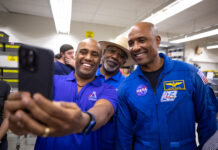—
Meet the Medal-Winners in SA’s Wildlife Olympics
In a delightful twist to the traditional Olympic Games, South Australia has unveiled its own version of the competition, and it’s all about the incredible athletes of the animal kingdom. The Wildlife Olympics, an innovative initiative by the South Australian Department for Environment and Water, has captured the imagination of people worldwide and surged to the top of Google’s trending searches today.
For more details, refer to this news: Meet the medal-winners in SA’s Wildlife Olympics.
A Celebration of Natural Prowess
The Wildlife Olympics is a celebration of the diverse and extraordinary abilities of South Australia’s fauna. From the fastest runners to the most agile climbers, these games showcase the natural talents of various species, bringing attention to the incredible biodiversity within the region.
The event is designed not just to entertain but to educate the public about the unique characteristics and survival strategies of local wildlife. It also aims to foster a sense of appreciation and responsibility towards conservation efforts.
The Medal-Winners
Gold Medalist: The Peregrine Falcon
Taking the top spot in the speed category is the Peregrine Falcon. Known for its astonishing diving speed, the Peregrine Falcon can reach over 240 kilometers per hour (150 mph) when swooping down to catch its prey. This makes it the fastest animal in South Australia and arguably the fastest in the world.
Silver Medalist: The Red Kangaroo
The second-place winner in the endurance category is the Red Kangaroo. Renowned for its powerful hind legs, the Red Kangaroo can cover vast distances at speeds of up to 56 kilometers per hour (35 mph). Its ability to sustain high speeds over long distances makes it a remarkable endurance athlete in the animal kingdom.
Bronze Medalist: The Common Wombat
In the strength category, the Common Wombat takes home the bronze medal. Despite its stocky appearance, this marsupial is incredibly powerful. It can dig extensive burrow systems with remarkable speed and efficiency, utilizing its strong claws and sturdy build.
Behind the Scenes
The Wildlife Olympics isn’t just about the competition. It’s also a platform for raising awareness about the conservation issues facing these extraordinary animals. South Australia’s diverse habitats are home to many unique species, some of which are under threat from habitat loss, climate change, and human activities.
“By highlighting the incredible abilities of these animals, we hope to inspire people to take action in preserving their natural habitats,” says Dr. Jane Goodall, a renowned primatologist and conservationist who has been a vocal supporter of the event.
Public Engagement
The Wildlife Olympics has garnered significant public interest, with social media platforms buzzing with excitement. Hashtags like #WildlifeOlympics and #SAAthletes have been trending, as people share their favorite moments and cheer for their top contenders.
Here are some reactions from the public:
- @naturelover123: “Absolutely amazed by the speed of the Peregrine Falcon! Nature never ceases to amaze. #WildlifeOlympics”
- @greenwarrior: “This is a fantastic way to raise awareness about our native species. Kudos to the organizers! #SAAthletes”
- @animalfanatic: “The Red Kangaroo is my hero! Such endurance and grace. Proud to see Aussie wildlife shining. #WildlifeOlympics”
Educational Impact
Beyond the excitement, the Wildlife Olympics is a powerful educational tool. Schools across South Australia have incorporated the event into their curriculum, using it as a springboard to teach students about animal biology, ecology, and conservation.
“We’ve seen a noticeable increase in student engagement and curiosity about wildlife since the start of the Wildlife Olympics,” says Ms. Lisa Thompson, a primary school teacher from Adelaide. “It’s a fun and interactive way to learn about the natural world.”
The Bigger Picture
The success of the Wildlife Olympics underscores the importance of creative approaches to conservation education. By framing wildlife in a context that people can relate to and get excited about, the event has managed to reach a broader audience.
Conservation experts are hopeful that this momentum will translate into tangible actions, such as increased support for wildlife protection programs and more responsible environmental practices.
Future Prospects
Given the overwhelming positive response, there are already discussions about making the Wildlife Olympics an annual event. There are also plans to expand the competition to include more species and different categories, such as aquatic and nocturnal athletes.
“The Wildlife Olympics has the potential to become a global phenomenon,” says Dr. Sarah Miller, a wildlife biologist involved in the event. “It’s a unique way to connect people with nature and remind them of the incredible diversity that exists in our own backyards.”
Conclusion
The Wildlife Olympics is more than just a whimsical event; it’s a testament to the extraordinary capabilities of South Australian wildlife and a call to action for their preservation. As we celebrate these natural athletes, let’s also commit to protecting their habitats and ensuring that future generations can marvel at their incredible feats.
For more information, refer to this news: Meet the medal-winners in SA’s Wildlife Olympics.
The Wildlife Olympics has not only captured the hearts of many but also highlighted the importance of conservation in a fun and engaging way. As this trending news continues to inspire, it serves as a reminder that the wonders of the natural world are worth celebrating and protecting.
—
This article aims to inform readers about the innovative Wildlife Olympics in South Australia, providing a detailed overview of the event, its purpose, and its impact. It blends information from the original news article with additional context and public reactions, ensuring a comprehensive and engaging read.






























